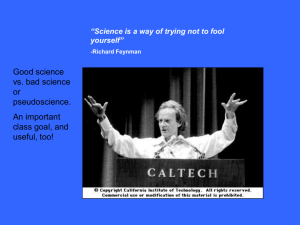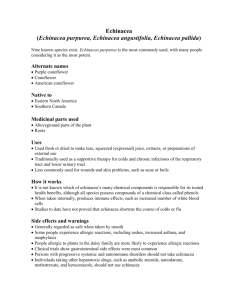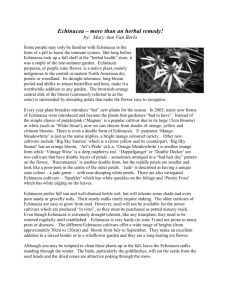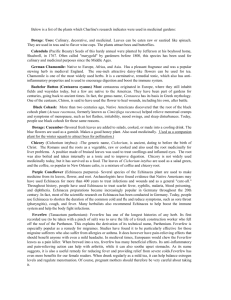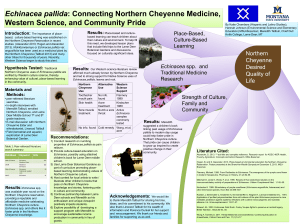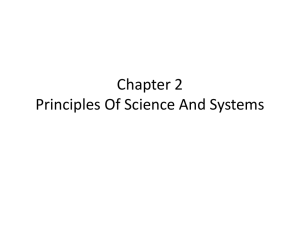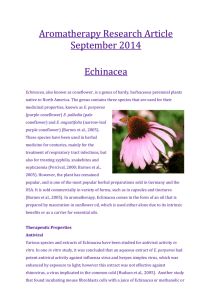Nature of Science PowerPoint - Panhandle Area Educational
advertisement
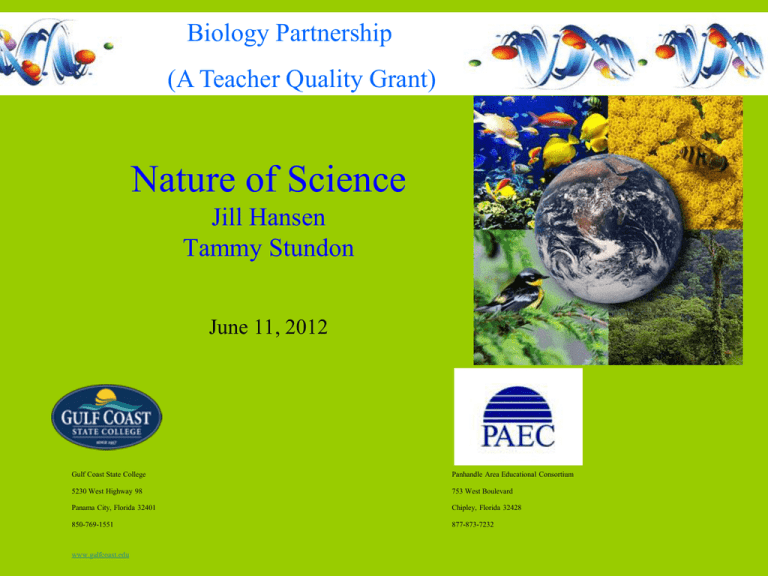
Biology Partnership (A Teacher Quality Grant) Nature of Science Jill Hansen Tammy Stundon June 11, 2012 Gulf Coast State College Panhandle Area Educational Consortium 5230 West Highway 98 753 West Boulevard Panama City, Florida 32401 Chipley, Florida 32428 850-769-1551 877-873-7232 www.gulfcoast.edu Pre-test Q and A board Bell Ringer Science Knowledge Survey Florida Next Generation Sunshine State Standards • SC.912.N.1.1 – define a problem based on a specific body of knowledge, for example: biology, chemistry, physics, and earth/space science and do the following: – Pose questions - conduct observations – Review evidence - plan investigations – Pose answers/explanations - examine known resources - use tools to gather info - communicate results Also Assesses: SC.912.N.1.4 – Identify sources of info SC.912.N.1.6 – scientific inferences SC. 912.L.14.4 – microscopes and various language/math standards on communication & analysis Florida Next Generation Sunshine State Standards Clarifications: • Students will design a scientific investigation using evident of scientific thinking. • Students will interpret and analyze data to make predictions and/or defend conclusions • Students will compare/contrast the structure/function of a microscope (compound, dissecting, scanning electron) • Students will evaluate the merits of scientific explanations produced by others • Students will assess the reliability of sources of info • Student will describe how scientific inferences are made from observations and identify examples from biology Prior knowledge: lot of standards from 6th – 8th grades Florida Next Generation Sunshine State Standards • SC.912.N.3.4 – recognize that theories do not become laws, nor do laws become theories; theories are well supported explanations and laws are well supported descriptions Includes standards: N.1.3-4, N.1.6.7, N.2.1-2, N.3.1, N.3.4 Content limits: Items assessing scientific claim, the development of a theory, or the difference between theories and laws are limited to the cell theory Cognitive complexity: Moderate Florida Next Generation Sunshine State Standards Clarifications: • Students will describe how continuous investigations and/or new scientific information influenced the development of the cell theory. • Students will identify ways in which a scientific claim is evaluated (e.g., through scientific argumentation, critical and logical thinking, and consideration of alternative explanation) • Students will identify what is science, what is not science, and what resembles but fails to meet the criteria for science. • Students will explain the development of a theory. • Students will recognize the difference between theories and laws Florida Next Generation Sunshine State Standards Some of the other standards included: SC.912.N.1.3 Recognize that the strength or usefulness of a scientific claim is evaluated through scientific argumentation, which depends on critical and logical thinking, and the active consideration of alternative scientific explanations to explain the data presented. SC.912.N.2.1 Identify what is science, what clearly is not science, and what superficially resembles science (but fails to meet the criteria for science). SC.912.N.3.1 Explain that a scientific theory is the culmination of many scientific investigations drawing together all the current evidence concerning a substantial range of phenomena; thus, a scientific theory represents the most powerful explanation scientists have to offer. Our Approach • This summer we are going over topics as if school is just beginning • The first few days of class are usually some housekeeping issues, getting to know your kids, lab safety, reviewing Latin terms in class, microscopes, and discussing lab reports. We will include such activities throughout this summer session when time allows. Today….. • How to introduce the topic • Setting the foundation • Scientific method • Science Inquiry Model and Argumentative Driven Inquiry • Note that these standards transcends throughout the entire course THINK about the Nature of Science Activity • Students are an important active participate in the learning process • Students need to realize that science is dynamic, hands-on, and changes as our knowledge of the world increases • Directions: There are NONE! THINK about the Nature of Science Activity • New information given…… • In groups brainstorm and share how this activity is similar to “doing” science JANE GOODALL & DIAN FOSSEY CURIOSITY STARTED IT ALL IT ALL STARTS WITH CURIOSITY Questions all around you…. Is Global Warming, do diet pills work, etc • FALSE CLAIMS------BUYER BEWARE !!!!! Question the claims on packages - How do you know it wards off colds? So how do we ensure what we find out is sound, not made up, and is supported? Scientific Method! Testable Repeatable Quantifiable Through the scientific method we gain empirical knowledge that is not only repeatable, testable but rational as well. Why is it important to have “biological literacy” – look at what is in the news! Pros/cons? - Pavlov’s Dog RATS SUPERSTITIOUS BEHAVIOR Absence of the Scientific Method! HUMAN SUPERSTITIOUS BEHAVIOR Absence of the Scientific Method! Others? HOW DO WE USE THE SCIENTIFIC METHOD It relies on rational testable and repeatable observations SCIENTIFIC METHOD You will find variations in every textbook and teacher stressing different area. The test gives the scientific method its validity. The steps are “self-correcting.” The steps do not have to be in order. What does this mean? Steps: 1. Observations and develop a question 2. Hypothesis 3. Develop a DETAILED procedure (PB & J!) 4. Gather materials 5. Experimentation 6. Data results 7. Conclusion Steps: 1. Observations and develop a question 2. Hypothesis • Definition (and this is my personal one) - educated STATEMENT - testable - has the possibility to be true. - can be an IF……THEN statement • Null versus True Hypothesis 3. Develop a DETAILED procedure - Very important that your experiments can be repeated. Why? 4. Gather materials 5. Experiment: - variables – test only one at a time - Independent and dependent variables - Independent – the variable that is varied or manipulated by the researcher - Dependent – the response to the independent - Control group versus experimental group - Must have data to compare the experimental data go; makes your findings more precise and not just accurate - Lab versus field experiment 6. Data – MATH - Data tables, graphs – no interpretations 7. Draw conclusions and make revisions - Interpretation of data. - Was your hypothesis correct? - What did you learn in the process? - Is it ok if everything went wrong? - What would you have done different? THE SCIENTIFIC METHOD STEP 1 Make observations. STEP 2 Formulate a hypothesis. STEP 3 Devise a testable prediction. STEP 4 Conduct a critical experiment. STEP 5 Draw conclusions and make revisions. The scientific method rarely proceeds in a straight line. Conclusions, for example, often lead to new observations and refined hypotheses. Termite Activity Then Break! Bell Ringer Obtaining reliable data is a must! • Getting the data Why we must have an experiment with data……. Why we can’t use correlations to make conclusion.…. • RELIABILITY OF EYEWITNESS TESTIMONY— you can’t always believe what you see. awareness clip STEP 1 STEP 2 STEP 3 STEP 4 STEP 5 STEP 1: MAKE OBSERVATIONS OBSERVATION: To many people, consuming Echinacea extract seems to reduce the intensity or duration of symptoms of the common cold. STEP 1 STEP 2 STEP 3 STEP 4 STEP 5 STEP 2: FORMULATE A HYPOTHESIS HYPOTHESIS: Echinacea reduces the duration and severity of the common cold. What would the Null Hypothesis be? STEP 1 STEP 2 STEP 3 STEP 4 STEP 5 STEP 3: DEVISE A TESTABLE PREDICTION Individuals treated with echinacea. Individuals not treated with echinacea. PREDICTION: If Echinacea reduces the duration and the severity of symptoms of the common cold, then: • Individuals taking Echinacea should get sick less frequently than those not taking it. • Individuals who get sick should recover more quickly. STEP 1 STEP 2 STEP 3 STEP 4 STEP 5 STEP 4: CONDUCT A CRITICAL EXPERIMENT EXPERIMENTAL GROUP Researchers randomly divided 437 volunteers into four groups to test the effect of Echinacea on the common cold. Group 1 Group 2 Group 3 Group 4 EXPERIMENTAL GROUP Researchers randomly divided 437 volunteers into four groups to test the effect of Echinacea on the common cold. Group 1 Group 2 Group 3 Group 4 TREATMENT (BEFORE EXPOSURE) No treatment One placebo tablet daily One Echinacea tablet daily Groups 1 and 2 receive tablets for 7 days longer than groups 3 and 4, in order to determine if treatment prior to exposure has any effect on the development or duration of symptoms. Which is the exp. group and which is the control group? TREATMENT (BEFORE EXPOSURE) No treatment One placebo tablet daily One Echinacea tablet daily Groups 1 and 2 receive tablets for 7 days longer than groups 3 and 4, in order to determine if treatment prior to exposure has any effect on the development or duration of symptoms. After one week, all individuals are exposed to a cold-causing virus. After one week, all individuals are exposed to a cold-causing virus. TREATMENT (AFTER EXPOSURE) One placebo tablet daily One Echinacea tablet daily One placebo tablet daily HEALTH EVALUATION For five days, doctors monitor all groups for cold symptoms. One Echinacea tablet daily STEP 1 STEP 2 STEP 3 STEP 4 TREATMENT STEP 5 CONCLUSIONS Placebo before and after exposure to cold virus Echinacea before and after exposure to cold virus Placebo after exposure to cold virus Echinacea after exposure to cold virus • Individuals from all four groups are just as likely to develop a cold. • Cold symptoms lasted for the same amount of time in all groups. • Echinacea had no effect on the duration or severity of the cold. FURTHER EXPERIMENTATION • Alter the amount of Echinacea given to subjects. • Alter the length of time subjects receive the Echinacea treatment. Experimental conclusions often generate ideas for further experimentation. Like what? THEORY: (A SCIENTIFIC THEORY IS USED DIFFERENTLY THEN HOW IT IS USED IN THE GENERAL PUBLIC) An explanatory hypothesis for a natural phenomenon that is exceptionally well supported by the empirical data (obtained by the experiments) It has withstood the test of time and is unlikely to be altered by any new evidence. It is viewed by the scientific community as nearly the same confidence of a fact. TWO IMPORTANT BIOLOGICAL THEORIES: 1. CELL THEORY - ALL ORGANISMS ARE MADE OF CELLS 2. THEORY OF EVOLUTION BY NATURAL SELECTION - that species changes over time EX: MAMMOTH -> MODERN ELEPHANT Be careful on the illustrations/graphs you use! • SC.912.N.3.4 – recognize that theories do not become laws, nor do laws become theories; theories are well supported explanations and laws are well supported descriptions Fun with Bubbles • Distinguish between qualitative and quantitative data • Utilize the tools of measurement and emphasize the importance of the metric system PSEUDOSCIENCE: Scientific-sounding claims that are not supported by methodical scientific studies. It capitalizes on the beliefs shared by most people but the scientific bases for a scientific sounding claim are NOT true. EX: “4 out of 5 dentists recommend sugarless gum; Astrology – planet positions affect your ability to get a new job. ANECDOTAL OBSERVATIONS: These are based on only one or just a few observations. People conclude that there are a link or correlation between two things. This can seem harmless but can be emotionally powerful and frequently deflects from the real issue. EX: HOROSCOPES, VACCINES CAUSE AUTISM COULD THE HORSE REALLY DO MATHEMATICAL CALCULATIONS ??? SUBTLE HINTS AND BODY LANGUAGE--SHOULD HAVE USED ‘BLIND’ EXPERIMENTAL DESIGN PSEUDOSCIENCE AND ANECDOTAL EVIDENCE. WHAT IS THE TRUTH ?????? The Fortune Teller Miracle Fish Watch as the fortune teller miracle fish's movements decide your fortune! Can you figure it out? Form a hypothesis and test it! Oobleck A non-Newtonian liquid! Can you explain what is happening? Follow up • Q&A • Post Test • Give-a-ways
